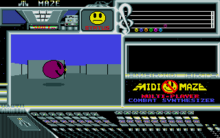MIDI Maze
MIDI Maze is a networked first-person shooter for the Atari ST developed by Xanth Software F/X and released in 1987 by Hybrid Arts. The game takes place in a maze of untextured walls. The world animates smoothly as the player turns, much like the earlier Wayout, instead of only permitting 90 degree changes of direction. Using the MIDI ports on the Atari ST, the game is said to have introduced deathmatch combat to gaming in 1987. The game found a wider audience when it was converted to Faceball 2000 on the Game Boy.
| MIDI Maze | |
|---|---|
 Cover art | |
| Developer(s) | Xanth Software F/X |
| Publisher(s) | Hybrid Arts Bulletproof Software |
| Platform(s) | Atari ST, Game Boy, Game Gear, SNES, PC-Engine CD-ROM |
| Release | Atari ST: July 10, 1987 June 23, 1991 July 31, 1992 June 15, 1993 |
| Genre(s) | First-person shooter |
| Mode(s) | Multiplayer |
Gameplay

Up to 16 computers can be networked in a "MIDI Ring" by daisy chaining MIDI ports that are built into the Atari ST series.
The game area occupies only roughly a quarter of the screen and consists of a first-person view of a flat-shaded maze with a crosshair in the middle. All players are shown as Pac-Man-like smiley avatars in various colors.[1][2] Bullets are represented as small spheres.
The game is started by a designated master machine, which sets rules, divides players into teams, and selects a maze. A number of mazes come with the game, and additional mazes can be constructed using a text-editor.
Faceball 2000
A Game Boy version was developed by the original development company, Xanth Software F/X, and published in 1991 by Bulletproof Software, with the title Faceball 2000.[3] James Yee, owner of Xanth, had the idea of porting the 520ST application to the Game Boy. George Miller was hired to rewrite the AI-based drone logic, giving each drone a unique personality trait.
A Super Nintendo Entertainment System version was released in 1992, supporting two players in split-screen mode. The SNES version features completely different graphics and levels from the earlier Game Boy version. A variety of in-game music for this version was composed by George "The Fat Man" Sanger.
A Game Gear version was released to the Japanese market.[4] It is a colorized version of the monochrome Game Boy version, supporting two players with two handheld consoles connected by a cable.
A version for the PC-Engine CD-ROM, titled Faceball, was released in Japan. A multiplayer networked version for the IBM PC was prototyped, but never released. Faceball was nearly completed and built for Nintendo's Virtual Boy console, but it was canceled.
Development
The original MIDI Maze team at Xanth Software F/X consisted of James Yee as the business manager, Michael Park as the graphic and networking programmer, and George Miller writing the AI and drone logic.
Reception
Entertainment Weekly picked Faceball 2000 as the #5 greatest game available in 1991, saying: "The Game Boy meets virtual reality (i.e., artificial, computer-enhanced, first-person perspective). In Faceball 2000, you assume the identity of a Holographically Assisted Physical Pattern Yielded for Active Computerized Embarkation — or HAPPYFACE — and hunt down your opponents. You can play alone or link up with as many as three additional players. More fun than real-life tag, and much more stimulating."[5] In 1994, Sandy Petersen reviewed the game for Dragon magazine, giving it 2 out of 5 stars.[6]
CNET Gamecenter called MIDI Maze one of the 10 most innovative computer games of all time.[7]
Legacy
Personal Computer World said that in 1987, MIDI Maze introduced the concept of deathmatch combat, using the built-in MIDI ports of the Atari ST for networking.[8]
A prototype of MIDI Maze was found for the Atari 8-bit family. It is possible to network an Atari ST and 8-bit for multiplayer mode.[9]
MIDI-Maze II was later developed by Markus Fritze for Sigma-Soft and released as shareware.
See also
References
- "25 years of Pac-Man". MeriStation. July 4, 2005. Retrieved 2011-05-06. (Translation)
- "Gaming's Most Important Evolutions". GamesRadar. October 8, 2010. p. 5. Retrieved 2011-04-27.
- Schiffmann, William. "In your Face! New toy will wow Game Boy owners." Chicago Sun-Times. 1992-05-22. Retrieved 2012-10-21 via HighBeam Research URL.
- Komarechka, Don. "Interview: EPO talks to Darren Stone about Faceball 2000." Electric Pickle Online. 2006-03-19. Retrieved 2012-10-21.
- Video Games Guide, Bob Strauss, November 22, 1991, EW.com
- Petersen, Sandy (January 1994). "Eye of the Monitor". Dragon. No. 201. pp. 57–62.
- Features - The Hall of Game Innovation, GAMECENTER.COM, ...Midi Maze...Hybrid Arts...Derivatives: Doom and its countless clones...
- Thomson, Iain (February 21, 2008). "Gaming Timeline". Personal Computer World. Archived from the original on June 29, 2014. Retrieved June 14, 2020.
- Reichert, Matt. "MIDI Maze". AtariProtos.com. Retrieved 2007-11-27.
External links
- MIDI Maze at Atari Mania
- Faceball 2000, #25 of 1UP's Essential 50